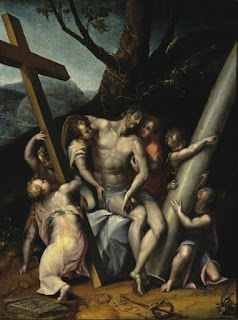NEW - Lavinia Fontana – artist
Mother-of-11 was Italy’s first female professional painter
Bolognese Mannerist artist Lavinia Fontana, who became famous for her portraits, died on this day in 1614 in Rome. She has come to be regarded as the first female professional painter in both Italy and throughout western Europe because her family lived on her income from commissioned works. Her husband worked as her assistant and agent and helped her bring up their 11 children. Lavinia was born in Bologna in 1552 and baptised at the Basilica di San Petronio in the city. Her father, Prospero, was a prominent artist of the Bolognese school and trained Lavinia to follow in his footsteps. This allowed her to become an artist at a time when women were not widely accepted in the profession. Her earliest known work, Child of the Monkey, was painted in 1575 when she was 23, but is now lost. Another early painting, Christ with the Symbols of the Passion, which was painted in 1576, is now in the El Paso Museum of Art in Texas. Bologna society was largely supportive of Lavinia’s career, providing opportunities that were not given to women artists in other areas of Italy. She is thought to be the first woman artist working within the same sphere as her male counterparts to live outside a court or a convent. Read more…
_____________________________________
Alfredo Binda - cyclist
Five times Giro winner who was paid not to take part
The five-times Giro d’Italia cycle race winner Alfredo Binda, who once famously accepted a substantial cash payment from the race organisers not to take part, was born on this day in 1902 in the village of Cittiglio, just outside Varese in Lombardy. The payment was offered because Binda was such a good rider - some say the greatest of all time - that the Gazzetta dello Sport, the daily sports newspaper that invented the race, feared for the future of the event - and their own sales - because of Binda’s dominance. He had been the overall winner of the coveted pink jersey in 1925, 1927, 1928 and 1929, on one occasion winning 12 of the 15 stages, on another racking up nine stage victories in a row. Binda, who was perceived as a rather cold and detached competitor, was never particularly popular outside his own circle of fans and his habit of ruthlessly seeing off one hyped-up new challenger after another did nothing to win him new fans. By 1929 it became clear to the Gazzetta’s bosses that interest in the race was waning, sales of the famous pink paper were falling and advertisers were less willing to part with their cash. Read more…
____________________________________
Massimiliano Allegri - football coach
Former AC Milan boss topped Conte's record
Massimiliano Allegri, the man who looked to have taken on one of the toughest acts to follow in football when he succeeded Antonio Conte as head coach of Juventus, was born on this day in 1967 in Livorno. Conte won the Serie A title three times and the domestic double of Serie A and Coppa Italia twice in his three years as boss of the Turin club. Yet after Allegri took over in 2014 he exceeded Conte’s record, leading the so-called Old Lady of Italian football to the double in each of his first four seasons in charge before winning a fifth consecutive Serie A title in 2019. The 2016-17 scudetto - the club’s sixth in a row - set a Serie A record for the most consecutive titles. Allegri was well regarded as a creative midfielder but although there were high spots, such as scoring 12 Serie A goals from midfield in a relegated Pescara side in 1992-93, he enjoyed a fairly modest playing career which was marred by his suspension for a year as one of six players alleged to have conspired in fixing the result of a Coppa Italia tie while with the Serie B club Pistoiese. Read more…
_____________________________________
Pope Alexander VI
Scheming pontiff married off his children to secure power
Rodrigo Borgia became one of the most controversial popes in history when he took the title of Alexander VI on this day in 1492 in Rome. He is known to have fathered several illegitimate children with his mistresses and his reign became notorious for corruption and nepotism. Born in Valencia in Spain, Borgia came to Italy to study law at the University of Bologna. He was ordained a Deacon and then made Cardinal-Deacon after the election of his uncle as Pope Callixtus III. He was then ordained to the priesthood and made Cardinal-Bishop of Albano. By the time he had served five popes he had acquired considerable influence and wealth and it was rumoured that he was able to buy the largest number of votes to secure the papacy for himself. He had made himself the first archbishop of Valencia and when he was elected as Pope Alexander VI, following the death of Innocent VIII, his son, Cesare Borgia, inherited the post. Borgia had many mistresses, but during his long relationship with Vanozza dei Cattanei he had four children that he acknowledged as his own, Cesare, Giovanni, Lucrezia and Goffredo. Read more…
%20(2).png)


.jpg)
.jpg)






.jpg)
%20(2).jpg)
.jpg)
.jpg)
